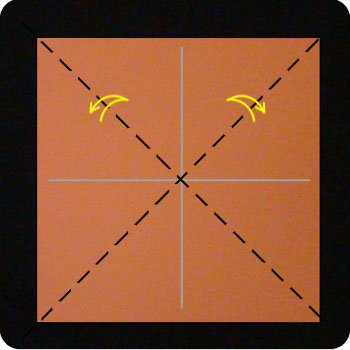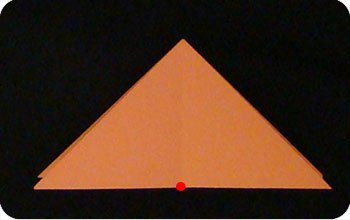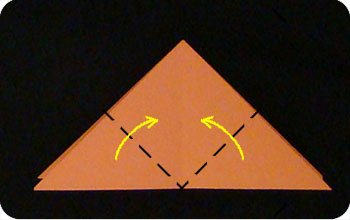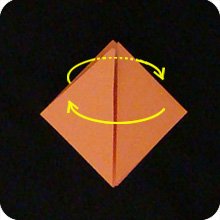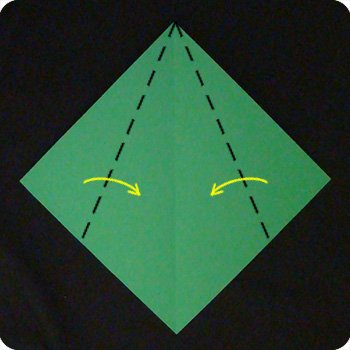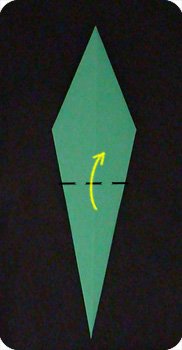

This origami tulip is three dimensional (not flat) and it comes with a stand in the shape of a stem & leaf. You will need two sheets of paper that is 6″ square in size (or larger). A brightly colored paper for the flower is recommended, and a green sheet of paper is good for the stem & leaf. Though, a slightly larger sheet for the stem wouldn’t hurt. As an alternatively, you can also wrap floral tape around a wooden skewer and use that as a stem (more about different stem origami tulip here).
Let’s start folding the flower part first:
Instructions for Origami Tulip

Step 1:
Start with a square sheet of paper: fold it in half (left to right) and unfold. Fold it in half (top to bottom) and unfold. If you are using paper that is a different color on the two sides, then start with the colored-side facing up. |
|
Step 2:
Turn the paper over. Fold the paper along the diagonals in both directions; unfold. This gives you a “X” shaped crease superimposed on the “+” crease made above. |
|
Step 3:
Bring the top-edge of the paper to meet with the bottom-edge of the paper (connect red dots). At the same time, push in the left and right sides. |
|
The paper will naturally fold along the creases you’ve already made. In transition… |
|
almost there… |
|
|
|
Step 4:
Working with the top layers only, fold the bottom tips to meet with the point at the top of the model. |
|
Step 5:
Turn the model over. |
|
Step 6:
Repeat step 4: fold the bottom tips to meet with the top point. |
|
Step 7:
Like turning the pages of a book, swivel one layer from the front-right towards the left side. At the same time, swivel one layer from the back of the model towards the right. |
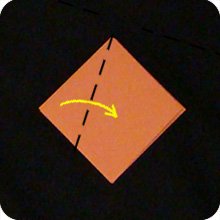
Step 8:
Working with the top layers only, fold the top-left edge of the paper pass the vertical midline. The amount of space you extend beyond the midline is up to personal taste and is not exact. |

Step 9:
Fold the right edge towards the left. Fold at approximately the same angle as the left flap. The two flaps should overlap a little. |

Step 10:
Pry open the layers of paper in one of the flaps. Insert the other flap into this space. The paper may buckle a little and that’s OK. If the paper buckles too much, adjust the folds in step 8 & 9 so the flaps overlap less. |

Step 11:
Turn the model over. |

Step 12:
Repeat steps 8 & 9 on this side of the model. Fold the left side in a little pass the vertical midline. |
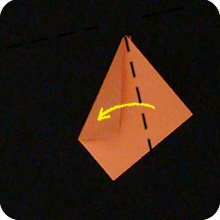 Fold in the right side in a similar manner. |
 Tuck one flap into the other flap. |

Step 13:
Spread apart the 4 edges so they are as far apart from one another as possible. |

Step 14:
At the top of the model, look for a single layer of paper which you can peel down and away from the rest of the flower. |
 Repeat on the other 3 edges. You should get 4 petals. |
 Top view of the origami tulip. |

Step 15:
Bottom view. Notice that there is a small hole at the bottom of the model. Blow air into this hole so the model puffs up. |
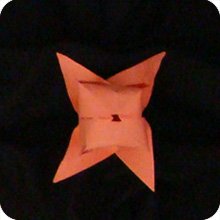 Bottom view of origami tulip after inflation. |
 You can adjust how far down to peel the petals. The origami tulip flower is done. Time to make the stem & leaf! |
Instructions for Stem and Leaf
The stem and leaf for this origami tulip is amazingly easy to make – less than 10 steps! It is quite sturdy and can stand up by itself.
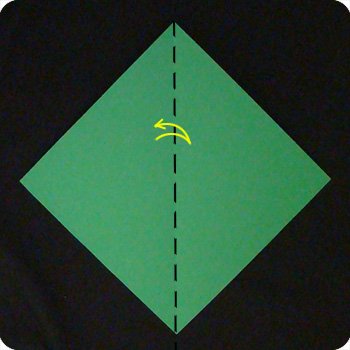
Step 1:
Start with a square sheet of paper of the same size (or larger) than the paper used for the tulip flower. Fold it in half, corner to corner. Unfold. |
|
Step 2:
Fold the top-left and top-right edges of the paper to the midline made above. |
|
Step 3:
Fold the bottom-left and bottom-right edges of the paper to the vertical midline. |
|
Step 4:
Repeat: fold the bottom-left and bottom-right edges of the model to the midline. This makes the stem more narrow compared to the leaf. |
|
Step 5:
Turn the model over. |
|
Step 6:
Fold the model in half (bring bottom to top). |
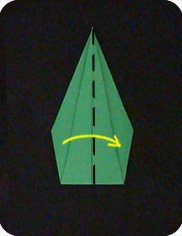
Step 7:
Fold model in half again (left to right). |

Step 8:
Finally, peel the outer layer of paper (leaf) away from the inner layer (stem). |
 Done! |
|
|
|
|
|
|
Instead of making the tulips stem with paper, you can also wrap floral tape around a wooden skewer
. Poke the skewer through the hole at the bottom of the tulip. This type of stem makes it easier to arrange the origami tulips as, for example, in a vase or in a bouquet.

Watch video:
